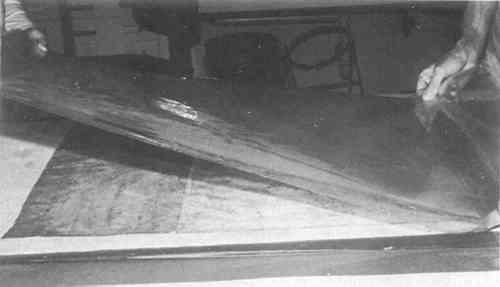CONSERVATION OF SCENIC WALLPAPERS: SAUVAGES DE LA MER DU PACIFIQUERobert Futernick
4 TREATMENTOF THE SEVERAL CONSERVATION principles that have come into general acceptance, the main tenet includes the concept that a procedure should not materially alter the character of an object, and that any method used could later be reversed without difficulty or risk to the art. At the outset of treatment of the Dufour papers, we hoped that some reduction of the mold staining and surface soiling would be safely We immediately experienced a setback. Test procedures indicated that because of the extreme water-solubility of some of the colors, plans to wash and release discoloration and acidity could not proceed. It was also learned that even minimal application of moisture to the reverse sides, necessary for other treatment procedures, caused certain soluble elements in the paper to move through the paint layer and become visible in the design. Treatment came to a standstill. It was at this time that consultation with conservators from the Pacific Regional Conservation Center proved most beneficial. The papers being treated in Hawaii were in much worse condition than ours. Flaking media was an extensive problem, but the conservators there were having success with the application of a very dilute, non-yellowing acrylic resin. A small amount of this material, dissolved in a non-aqueous solvent, could deeply penetrate paint layers, reattaching and consolidating loose media.1 No visible change in coloration occurred, and with the addition of this non-aqueous binder, the design became resistant to moisture. Water washing was now possible, and by incorporating this technique devised in Hawaii, we were able to proceed with the actual treatment.
1 2% B-72 w/v dissolved in solvent (toluene and xylenes, 50–50) was spray applied to paint surface. We constructed a sink large enough to accommodate one 24″ � 98″ panel.
2 Sekishu paper, 100% mulberry fibers, .005-inch in thickness.
The first day of washing saw only one panel bathed and lined. This rate of progress was viewed with dismay since the exhibition deadline was fast approaching. However, examination of the first washed panel, after drying, created no small amount of excitement and surprise. We had thought that when the fixative was applied, a portion of the existing discoloration would be bound into place. Instead, the water was able to dissolve and remove nearly all of the staining. A freshness of color was achieved that probably had not been seen since the time of the papers' printing. And as the days passed, our technique quickened. We were able to wash, line, and begin to dry upto four rolls in one day. Drying these large panels, as one might imagine, was cumbersome. Absorbent blotting paper had to be changed at regular intervals, and this meant dismantling our elaborate pressing and weighting system each time. This “system” consisted literally of a pile of bricks, a typewriter, lead weights, jugs of water and other laboratory items sufficiently affected by gravity, all set atop the blotting papers and plywood boards pressing the drying wallpapers. To provide additional strength, and to limit tightening and buckling with humidity changes, a secondary synthetic support system consisting of an inert polyester fabric3 and a temperature-sensitive adhesive4 was applied. A vacuum hot table, most often used for lining oil paintings, provided the necessary heat and pressure.
3 Reemay from duPont; non-woven polester web, No. 2114.
4 PVA Resin, AYAA-AYAF (50–50) in toluene. |
